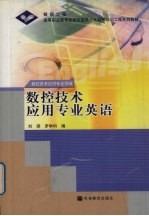图书介绍
数控技术应用专业英语PDF|Epub|txt|kindle电子书版本网盘下载

- 刘瑛,罗学科编 著
- 出版社: 北京:高等教育出版社
- ISBN:7040157063
- 出版时间:2004
- 标注页数:232页
- 文件大小:55MB
- 文件页数:242页
- 主题词:数控机床-英语-高等学校:技术学校-教材
PDF下载
下载说明
数控技术应用专业英语PDF格式电子书版下载
下载的文件为RAR压缩包。需要使用解压软件进行解压得到PDF格式图书。建议使用BT下载工具Free Download Manager进行下载,简称FDM(免费,没有广告,支持多平台)。本站资源全部打包为BT种子。所以需要使用专业的BT下载软件进行下载。如BitComet qBittorrent uTorrent等BT下载工具。迅雷目前由于本站不是热门资源。不推荐使用!后期资源热门了。安装了迅雷也可以迅雷进行下载!
(文件页数 要大于 标注页数,上中下等多册电子书除外)
注意:本站所有压缩包均有解压码: 点击下载压缩包解压工具
图书目录
Unit 1 Introduction of CNC Machine Tool1
1.1 Machining Center Configurations1
1.2 Vertical Machining Centers2
1.3 Horizontal Machining Centers5
1.4 Other Programmable Features of Machining Centers8
1.4.1 Spindle Speed8
1.4.2 Spindle Activation and Direction8
1.4.3 Spindle Range8
1.4.4 Feedrate8
1.4.5 Coolant9
1.4.6 Tool Changes9
1.4.7 What Else Might Be Programmable9
Exercises10
Unit 2 Tooling for CNC Machine12
2.1 Introduction12
2.2 Material for Cutting Tools13
2.3 The Practical Application of Cemented Carbides15
2.3.1 Solid Tools15
2.3.2 Brazed Tips15
2.3.3 Indexable Inserts16
2.4 Tooling Systems19
2.5 Automatic Tool Changer System22
2.5.1 Turret Head22
2.5.2 Carousel Storage with Spindle Direct Tool Changer23
2.5.3 Horizontal Storage Matrix Magazine with Pivot Insertion Tool Changer24
Exercises26
Unit 3 Program Zero and Coordinate System27
3.1 What is Coordinate System27
3.2 Plus and Minus30
3.3 Program Zero31
3.4 Absolute vs.Incremental33
Exercises35
Unit 4 Mathematics for NC Programming36
4.1 Introduction36
4.2 Geometry37
4.2.1 Properties of Intersecting Lines37
4.2.2 Tangency38
4.3 Trigonometry40
4.3.1 The Pythagorean Theorem40
4.3.2 Right Triangle Trigonometry41
4.3.3 Oblique Triangle Trigonometry44
Exercises48
Unit 5 Word Address Programming50
5.1 Introduction50
5.2 Programming Language Format50
5.3 Programming Language Terminology52
5.4 Program and Sequence Numbers(O,N Codes)53
5.5 Preparatory Functions(G Codes)55
5.6 Dimension Words(X,Y,Z,…Codes)56
5.7 Feedrate(F Codes)57
5.8 Spindle Speed(S Codes)57
5.9 Miscellaneous Machine Functions(M Codes)58
5.10 Why Learn Manual Programming59
Exercises62
Unit 6 Speeds and Feeds63
6.1 Cutting Speeds and Feeds63
6.2 Spindle Speeds65
6.3 Feed Rates67
6.3.1 Feed Rates for Turning68
6.3.2 Feed Rates for Milling69
6.3.3 Feed Rates for Drilling70
6.4 Feed Rate and Spindle Speed Override71
Exercises72
Unit 7 Preparation for Programming73
7.1 The Importance of Preparation73
7.2 Typical Mistakes74
7.2.1 Syntax Mistakes75
7.2.2 Motion Mistakes75
7.2.3 Mistakes of Omission76
7.2.4 Process Mistakes76
7.3 Steps for Preparing to Write a CNC Program77
7.3.1 Study and Mark Up the Print77
7.3.2 Prepare the Machining Process77
7.3.3 Develop the Needed Cutting Conditions81
7.3.4 Do the Required Math81
7.3.5 Check the Required Tooling83
7.4 Plan the Work Holding Setup84
7.5 Other Documentation85
7.5.1 Setup Sheet85
7.5.2 Program Listing86
7.6 Is It All Worth It86
Exercises87
Unit 8 Programming Techniques88
8.1 Introduction88
8.2 Programming Hole Operation88
8.3 Programming Linear Profiles90
8.4 Programming Circular Profiles91
8.4.1 Circular Interpolation Commands91
8.4.2 Circular Interpolation Via Direct Radius Specification92
8.4.3 Profiling Arcs at Constant Feed Rate94
8.5 Programming with Subprogram96
8.5.1 Subprogram Concept96
8.5.2 Commands for Calling a Subprogram and Returning to the Main Program97
8.5.3 General Rules for Subprogramming98
Exercises99
Unit 9 Three Kinds of Compensation100
9.1 Introduction100
9.2 What is Compensation101
9.3 Understanding Offsets103
9.3.1 How Many Offsets do You Have104
9.3.2 Offsets and Trial Machining104
9.3.3 Organization of Offsets105
9.3.4 Wear Offsets Versus Geometry Offsets106
9.3.5 How Offsets are Instated106
9.4 Tool Length Compensation108
9.4.1 The Reason for Tool Length Compensation108
9.4.2 How Tool Length Compensation is Used110
9.5 Cutter Radius Compensation111
9.5.1 Reasons for Using Cutter Radius Compensation112
9.5.2 How does Cutter Radius Compensation Work116
9.6 Fixture Offsets117
Exercises118
Unit 10 Machine Design120
10.1 Repeatability120
10.2 Basic Structure122
10.3 Machine Spindles123
10.4 Spindle Drives126
10.5 Machine Slides128
10.6 Slide Drives130
Exercises133
Unit 11 Setup and Maintain135
11.1 Tasks Related to Setup and Operation135
11.1.1 Setup Tasks Versus Production Maintaining Tasks136
11.1.2 Tasks Related to Setup137
11.2 Tasks Related to Maintaining Production143
11.2.1 Workpiece Unload and Load144
11.2.2 Maintaining Critical Dimensions(with Close Tolerances)during Each Tool's Life145
11.2.3 Replacing Worn Tools147
11.3 Other Possible Tasks to be Done During the Production Run149
Exercises150
Unit 12 Three Modes of Operation151
12.1 The Manual Mode152
12.2 The Manual Data Input Mode153
12.2.1 The Manual Data Input Position of the Mode Switch154
12.2.2 The Edit Position of the Mode Switch155
12.3 The Program Operation Mode157
12.3.1 The Memory(or Auto)Mode Switch Position159
12.3.2 The Tape Mode Switch Position160
Exercises162
Unit 13 Program Verification Techniques163
13.1 Introduction163
13.2 Safety Priorities165
13.2.1 Operator Safety165
13.2.2 Machine Tool Safety166
13.2.3 Workpiece Safety167
13.3 Typical Mistakes168
13.3.1 Syntax Mistakes in the Program169
13.3.2 Motion Mistakes in the Program170
13.3.3 Setup Mistakes170
13.3.4 Mistakes of Omission171
13.4 Procedures to Program Verification172
13.4.1 The Machine Lock Dry Run172
13.4.2 Free Flowing Dry Run173
13.4.3 Normal Air Cutting Cycle Execution175
13.4.4 Running the First Workpiece176
13.4.5 Making Good Parts177
13.5 Conclusion to Program Verification178
Exercises179
Unit 14 CAD/CAM180
14.1 Introduction180
14.2 Computer-Aided Anything(CAA)181
14.3 What is CAD/CAM Software182
14.4 Description of CAD/CAM Components and Functions184
14.4.1 CAD Module184
14.4.2 CAM Module187
14.4.3 Geometry vs.Toolpath189
14.4.4 Tool and Material Libraries191
14.4.5 Verification and Post-Processor192
14.4.6 Portability193
14.5 Software Issues and Trends195
Exercises198
Appendix A G&M Code Reference199
Appendix B The Sample of CNC Machine Specification203
Appendix C Vocabulary208
References232